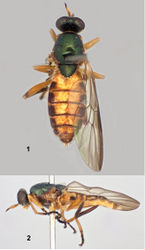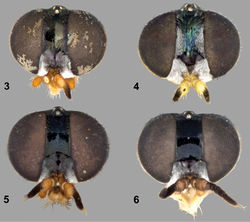Paraberismyia chiapas
| Notice: | This page is derived from the original publication listed below, whose author(s) should always be credited. Further contributors may edit and improve the content of this page and, consequently, need to be credited as well (see page history). Any assessment of factual correctness requires a careful review of the original article as well as of subsequent contributions.
If you are uncertain whether your planned contribution is correct or not, we suggest that you use the associated discussion page instead of editing the page directly. This page should be cited as follows (rationale):
Citation formats to copy and paste
BibTeX: @article{Woodley2013ZooKeys353, RIS/ Endnote: TY - JOUR Wikipedia/ Citizendium: <ref name="Woodley2013ZooKeys353">{{Citation See also the citation download page at the journal. |
Ordo: Diptera
Familia: Stratiomyidae
Genus: Paraberismyia
Name
Paraberismyia chiapas Woodley, 2013 sp. n. – Wikispecies link – ZooBank link – Pensoft Profile
Diagnosis
Paraberismyia chiapas can be distinguished from other species in the genus by the combination of having cell cup only partially covered with microtrichia and all of the abdominal sternites completely yellowish orange. The other species with cell cup only partly covered with microtrichia, Paraberismyia triunfo, has distinct dark markings on the sternites.
Description
Male. Unknown.
Female (Figs 1, 2). Head: Black, without metallic reflections except upper frons has very faint greenish reflections (Figs 1, 3); upper frons 0.25 width of head at anterior ocellus; upper frons very finely punctate; lower frons and face densely grayish white tomentose, lower frons with medial, rounded bare area which extends from upper frons, occiput also tomentose except for median occipital sclerite, but tomentum is darker, brownish gray; upper frons with short, sparse pale hairs about one-half length of scape; face with pale hairs about two-thirds length of scape; gena with pale yellowish hairs a little longer than those of face, occiput with pale hairs becoming progressively shorter above gena; eye densely pilose, hairs pale, less than half length of scape; antenna 1.10 times length of head; first two segments and flagellomeres 1–5 yellowish, apical 3 flagellomeres brownish; first two antennal segments with stiff black hairs, longer hairs on flagellum black; palpus yellow, with numerous long hairs, most of which are pale yellowish, a few dark hairs present at apex of second segment; proboscis yellow. Thorax: Scutum and scutellum dark metallic green (Fig. 1), postpronotal lobe and postalar callus dark yellow; pleura yellowish orange with ventral two-thirds of anepisternum, entire katepisternum and anterior two-thirds of anepisternum, and posterior half of meron brown to brownish black (Fig. 2) and subscutellum and mediotergite similarly colored; scutum and scutellum finely, densely punctate; thorax with inconspicuous pale tomentum present on prothorax, anepimeron, meron, subscutellum and mediotergite, difficult to observe; anepisternum on dorsal half bare and shiny medially; mostly pilose with more or less erect pale hairs, those on scutum and scutellum slightly appressed, about length of pedicel on dorsum, ranging to length of scape + pedicel on pleura with middle of anepisternum, entire katepimeron, meron, mediotergite, and subscutellum bare; legs (Fig. 2) yellowish, but hind femur with brownish area on extreme dorsoapical region, front tibia vaguely suffused with brownish color, hind tibia dark brownish except of extreme base and indistinct area ventrally on proximal half, front and middle tarsi are brownish-black except for basal two-thirds of basitarsi, although yellowish coloration is somewhat obscured by dark pilosity, hind tarsus brownish black but basitarsus is wholly yellow; legs short pilose, posterior surfaces of middle and hind femora with sparse, scattered longer hairs, posteroventral surface of hind tibia with a few longer hairs, coloration of pilosity generally similar to cuticular ground color, except basitarsi have some darker hairs on pale regions; wing hyaline with moderate brownish infuscation on anterior one-third and apex, veins brownish, yellowish at extreme base of wing; wing entirely covered with microtrichia except cell cup is bare except at base and apex; halter yellowish, knob vaguely suffused with brownish.
Abdomen: Tergites brownish, except first tergite and central two-thirds of tergites 2–6 dark yellow with narrow extensions of yellow reaching lateral margin at anterior corners of tergites 3–5 (Fig. 1); tergite 7 similar but less distinctly marked, tergal grooves on tergites 2–5 brownish black; sternites entirely dark yellow except sternite 8 vaguely infuscated with brown; tergites vaguely, almost imperceptibly tomentose, quite shiny; pilosity of tergites mostly brownish and very short, some pale hairs on tergites 1 and 2, pilosity longer on lateral margins and wholly pale on tergite 1 and intermixed on tergites 2–4; sternites with short, yellowish hairs, a few dark hairs laterally on sternite 6, sternite 7 with pilosity completely brownish; cerci dark yellow, second segment ovoid and slightly shorter than first, with pale yellow hairs on both segments but dark hairs present at apex of second segment.
Length: 7.8 mm.
Distribution
Known only from the state of Chiapas, Mexico.
Type material
Holotype female (USNM), MEXICO: Chiapas, El Triunfo (49 km S of Jaltenango, 15°39.4'N, 92°48.5'W), 2000 meters, 13–15.v.1985, Amnon Freidberg. The holotype is missing the right antennal flagellum and the left wing, but is otherwise in good condition.
Etymology
The species epithet, chiapas, is a noun in apposition based on the state of Chiapas, Mexico, where the type locality is located.
Remarks
Although general coloration is difficult to characterize, in appearance this species has a more greenish mesonotum, and the yellow coloration is a little more orangish than in the other species.
Original Description
- Woodley, N; 2013: A revision of the Neotropical genus Paraberismyia Woodley (Diptera, Stratiomyidae, Beridinae) with three new species ZooKeys, 353: 25-45. doi
Images
|

